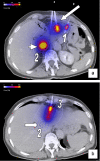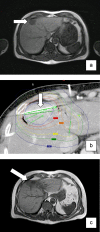Radiobiological restrictions and tolerance doses of repeated single-fraction hdr-irradiation of intersecting small liver volumes for recurrent hepatic metastases
- PMID: 20507615
- PMCID: PMC2887889
- DOI: 10.1186/1748-717X-5-44
Radiobiological restrictions and tolerance doses of repeated single-fraction hdr-irradiation of intersecting small liver volumes for recurrent hepatic metastases
Abstract
Background: To assess radiobiological restrictions and tolerance doses as well as other toxic effects derived from repeated applications of single-fraction high dose rate irradiation of small liver volumes in clinical practice.
Methods: Twenty patients with liver metastases were treated repeatedly (2 - 4 times) at identical or intersecting locations by CT-guided interstitial brachytherapy with varying time intervals. Magnetic resonance imaging using the hepatocyte selective contrast media Gd-BOPTA was performed before and after treatment to determine the volume of hepatocyte function loss (called pseudolesion), and the last acquired MRI data set was merged with the dose distributions of all administered brachytherapies. We calculated the BED (biologically equivalent dose for a single dose d = 2 Gy) for different alpha/beta values (2, 3, 10, 20, 100) based on the linear-quadratic model and estimated the tolerance dose for liver parenchyma D90 as the BED exposing 90% of the pseudolesion in MRI.
Results: The tolerance doses D90 after repeated brachytherapy sessions were found between 22 - 24 Gy and proved only slightly dependent on alpha/beta in the clinically relevant range of alpha/beta = 2 - 10 Gy. Variance analysis showed a significant dependency of D90 with respect to the intervals between the first irradiation and the MRI control (p < 0.05), and to the number of interventions. In addition, we observed a significant inverse correlation (p = 0.037) between D90 and the pseudolesion's volume. No symptoms of liver dysfunction or other toxic effects such as abscess formation occurred during the follow-up time, neither acute nor on the long-term.
Conclusions: Inactivation of liver parenchyma occurs at a BED of approx. 22 - 24 Gy corresponding to a single dose of ~10 Gy (alpha/beta ~ 5 Gy). This tolerance dose is consistent with the large potential to treat oligotopic and/or recurrent liver metastases by CT-guided HDR brachytherapy without radiation-induced liver disease (RILD). Repeated small volume irradiation may be applied safely within the limits of this study.
Figures






Similar articles
-
In vivo assessment of the tolerance dose of small liver volumes after single-fraction HDR irradiation.Int J Radiat Oncol Biol Phys. 2005 Jul 1;62(3):776-84. doi: 10.1016/j.ijrobp.2004.11.022. Int J Radiat Oncol Biol Phys. 2005. PMID: 15936559
-
Assessment of the tolerance dose of the hepatic reticulo-endothelial system (RES) after single fraction HDR-irradiation: an in-vivo study employing SSPIO.Int J Radiat Biol. 2008 Oct;84(10):830-7. doi: 10.1080/09553000802389660. Int J Radiat Biol. 2008. PMID: 18979318 Clinical Trial.
-
Safety margin in irradiation of colorectal liver metastases: assessment of the control dose of micrometastases.Radiat Oncol. 2010 Mar 24;5:24. doi: 10.1186/1748-717X-5-24. Radiat Oncol. 2010. PMID: 20334657 Free PMC article.
-
Quantitative in vivo assessment of radiation injury of the liver using Gd-EOB-DTPA enhanced MRI: tolerance dose of small liver volumes.Radiat Oncol. 2011 Apr 17;6:40. doi: 10.1186/1748-717X-6-40. Radiat Oncol. 2011. PMID: 21496320 Free PMC article. Clinical Trial.
-
Partial breast re-irradiation for local recurrence of breast carcinoma: Benefit and long term side effects.Breast. 2013 Aug;22 Suppl 2:S141-6. doi: 10.1016/j.breast.2013.07.026. Breast. 2013. PMID: 24074775 Review.
Cited by
-
Pathological complete response with immunotherapy and brachytherapy to 15 metastatic liver lesions in a single patient.Hepat Oncol. 2022 Sep 27;9(3):HEP44. doi: 10.2217/hep-2021-0014. eCollection 2022 Sep. Hepat Oncol. 2022. PMID: 36176484 Free PMC article.
-
In vivo assessment of catheter positioning accuracy and prolonged irradiation time on liver tolerance dose after single-fraction 192Ir high-dose-rate brachytherapy.Radiat Oncol. 2011 Sep 5;6:107. doi: 10.1186/1748-717X-6-107. Radiat Oncol. 2011. PMID: 21892943 Free PMC article.
-
Radiotherapeutic treatment options for oligotopic malignant liver lesions.Radiat Oncol. 2021 Mar 16;16(1):51. doi: 10.1186/s13014-021-01779-5. Radiat Oncol. 2021. PMID: 33726751 Free PMC article.
-
Critical review of multidisciplinary non-surgical local interventional ablation techniques in primary or secondary liver malignancies.J Contemp Brachytherapy. 2019 Dec;11(6):589-600. doi: 10.5114/jcb.2019.90466. Epub 2019 Dec 8. J Contemp Brachytherapy. 2019. PMID: 31969919 Free PMC article.
-
Radioablation of liver malignancies with interstitial high-dose-rate brachytherapy : Complications and risk factors.Strahlenther Onkol. 2016 May;192(5):288-96. doi: 10.1007/s00066-016-0957-0. Epub 2016 Feb 29. Strahlenther Onkol. 2016. PMID: 26923394 Clinical Trial. English.
References
-
- Herfarth KK, Debus J, Lohr F, Bahner ML, Rhein B, Fritz P. Stereotactic single-dose radiation therapy of liver tumors: results of a phase I/II trial. J Clin Oncol. 2001;19:164–170. - PubMed
-
- Mohnike K, Wieners G, Schwartz F, Seidensticker M, Pech M, Ruehl R. Computed Tomography-Guided High-Dose-Rate Brachytherapy in Hepatocellular Carcinoma: Safety, Efficacy, and Effect on Survival. Int J Radiat Oncol Biol Phys. 2010. - PubMed
-
- Ricke J, Mohnike K, Pech M, Seidensticker M, Ruhl R, Wieners G. Local Response and Impact on Survival After Local Ablation of Liver Metastases from Colorectal Carcinoma by Computed Tomography-Guided High-Dose-Rate Brachytherapy. Int J Radiat Oncol Biol Phys. 2010. - PubMed
MeSH terms
Substances
LinkOut - more resources
Full Text Sources
Medical

